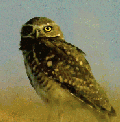

|
First Images from PUEO ! |
The very first corrected and uncorrected images we obtained. K band, magnitude 11.7, Seeing (0.5 microns) = 0.94 arcsec.
![[very first images]](Images/first_small.gif)
Examples of image profiles obtained on a V=9.2 star. Seeing at 0.5 microns was 0.68 arcsec (D/r0 = 24), i.e. worse than median seeing at Mauna Kea. As mentionned on the figure, Strehl ratios at J,H and K are 17.5%, 35% and 60% respectively (FWHM are 0.091, 0.105 and 0.1275). All images have been taken with integration time larger than 7 seconds.
![[J cross section]](Images/j_cross_s.gif)
![[H cross section]](Images/h_cross_s.gif)
![[K cross section]](Images/k_cross_s.gif)
A double star of measured 0.276 arcsec separation (easy), at H band.
![[double star image]](Images/double_small.gif)
Performance of the system on faint guide star : Compared to the expected
results, we found that we were off by roughtly 1 to 1.5 magnitude. The
overall transmission from the top of the telescope to the APD in the WFS is
17%. This is roughtly a factor 2 smaller than what was expected. This may
be attributable to the visible/infrared dichroic, or to the coupling with
the APD fibers. We have been able to close the loop without any problem on
V=15.2 stars, and get sensible image improvement in J,H and K (see figure
below). It is expected that we should be able to get some image improvement
with V=17 stars. We are currently investigating the transmission
problem. Below is a uncorrected/corrected image in K band, on a V=14.5
star. Seeing at 0.5 microns was 0.51 arcsec (D/r0 = 18), which
approximately the median seeing at Mauna Kea. The Strehl ratio of the
corrected image (right) is 29%.
![[double star image]](Images/mag14.5.gif)
and this superb high resolution image of NGC6093 in K band. Note that the
FWHM is 0.13 arcsec (diffraction limit at K) over almost the whole field of
view. This image is a mosaic of 12 individual images of 30 seconds exposure
time. Even with such a short exposure time, the magnitude range spans over
8 magnitudes. This illustrates the dramatic improvement in detection and
dynamic over seeing limited images (the flux being concentrated over a much
smaller sky area).
![[ngc6093 image]](Images/ngc_small.gif)